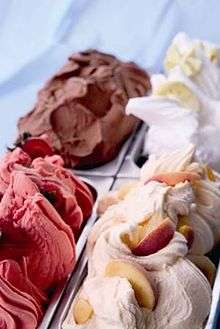Gelato
Gelato (Italian pronunciation: [dʒeˈlaːto]) is a popular frozen dessert of Italian origin. It is generally made with a base of 3.25% milk and sugar. It is generally lower in fat than other styles of frozen desserts.[1] Gelato typically contains 70% less air and more flavouring than other kinds of frozen desserts, giving it a density and richness that distinguishes it from other ice creams.[2][3]
 | |
| Type | Gelato |
|---|---|
| Place of origin | Italy |
| Serving temperature | Cold |
| Main ingredients | 3.25% milk, sugar, flavouring ingredient (e.g. – fruit or nut puree) |
Gelato in its modern form is credited to the Italian chef Francesco Procopio dei Coltelli who in the late 1600s opened his “Café Procope” in Paris and introduced gelato at his café, earning notability first in Paris and then in the rest of Europe. Thanks to his gelato, Procopio not only obtained French citizenship, but also got an exclusive royal licence issued by the Sun King Louis XIV, making him at the time the sole producer of the frozen dessert in the kingdom.[4]
Nowadays, gelato is known worldwide and Italy is the only country where the market share of artisanal gelato versus mass-produced gelato is over 55%,[5][6] with more than 5,000 modern Italian ice cream parlors employing over 15,000 people.[7] Outside of Italy the higher numbers of gelaterie are located in the UK, France, Germany and north Europe in general.
Flavours
The traditional flavours of gelato consist of vanilla, chocolate, hazelnut, pistachio, cream (also known as custard) and stracciatella (fior di latte gelato with chocolate chunks).[8] Fior di latte ("milk flower") is plain, base ice cream with no flavour and no eggs added.
More modern flavours consist of fruity flavours such as raspberry, strawberry, apple, lemon and pineapple.[8]
Production
The process consists of heating the ingredients to 85°C (185 °F) for pasteurisation. Then, it is lowered to 5°C (41°F) and mixed to the desired texture.
The cold process mixes the ingredients and is batched in the freezer.
In the "sprint" process, milk or water is added to a package of ingredients which is then mixed and batched.[9]
As with other ice creams, the sugar in gelato prevents it from freezing solid by binding to the water and interfering with the normal formation of ice crystals. This creates smaller ice crystals and results in the smooth texture of gelato.[10] American commercial gelati are typically sweetened with sucrose, dextrose, or inverted sugar, and include a stabilizer such as guar gum.
See also
- Custard, a dessert made with cream, eggs and vanilla
- Frozen custard, a frozen dessert made with cream and eggs
- Frozen yogurt, a frozen dessert made with a base of yogurt rather than milk
- Granita, a semi-frozen dessert made from sugar, water and various flavourings
- Italian ice, also known as water ice, a frozen dessert made from either concentrated syrup flavouring or fruit purees
- Semifreddo, a class of semi-frozen dessert
- Sorbet, called sorbetto in Italian
- Stracciatella
Notes
- M.T. Wroblewski (6 December 2018). "Nutrition Facts on Gelato Compared to Ice Cream". San Francisco Gate. Retrieved 20 August 2014.
- Ferrari, p. 21
- Sylvia Poggioli (17 June 2013). "Italian University Spreads The 'Gelato Gospel'". NPR. Retrieved 7 July 2016.
- Olga Stornello (1 November 2018). "Francesco Procopio dei Coltelli: the man who invented gelato". Sicilian Post. Retrieved 8 August 2019.
- "ItalianGelato.info".
- "GelatoArtigianale.it".
- Anna Russo (17 July 2004). "Food education | The fascinating story of ice cream". guide.superEva.it.
- "WhyGelato? | Because the Tradition of Simple Indulgence Never Gets Old". WhyGelato.com. Retrieved 16 April 2018.
- "WhyGelato? | Because There's More Than One Way to Create a Masterpiece". WhyGelato.com. Retrieved 24 April 2018.
- Omran, A. Monem (July 1974). "Kinetics of ice crystallization in sugar solutions and fruit juices". AIChE Journal. 20 (4): 795–803. doi:10.1002/aic.690200422.
References
- Ferrari, Luciano (2005). Gelato and Gourmet Frozen Desserts – A professional learning guide. Lulu.com. ISBN 978-1-4092-8850-3.